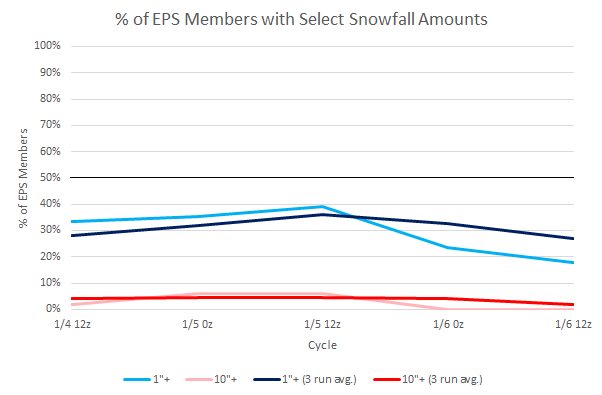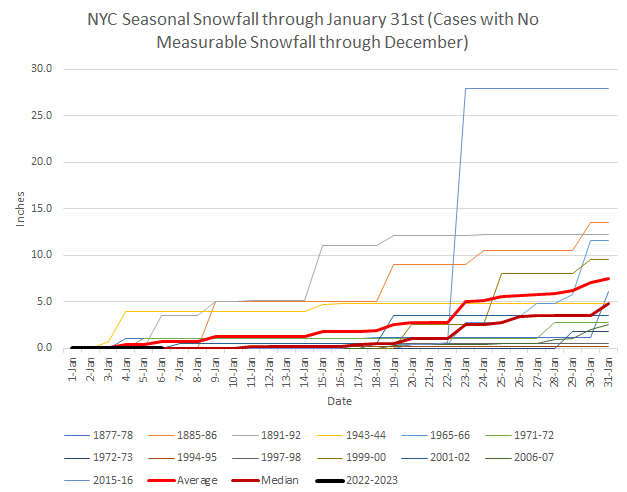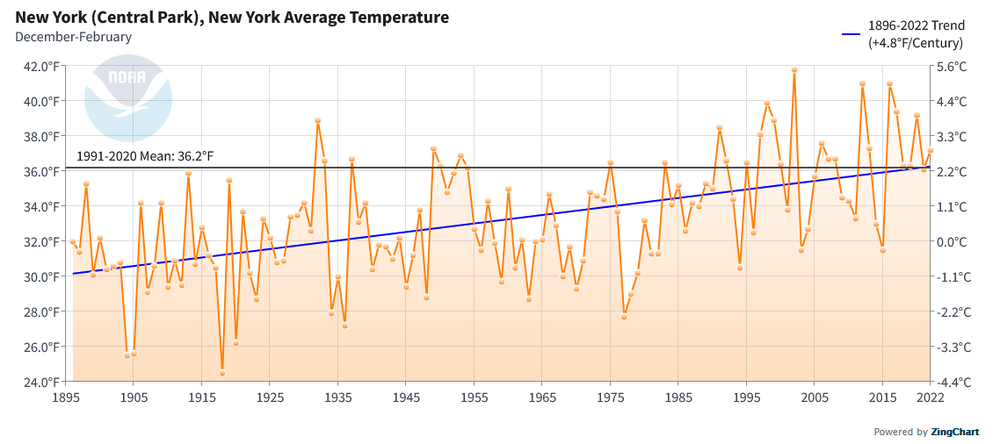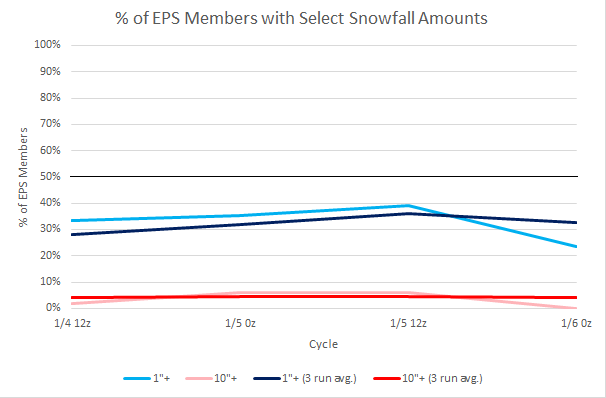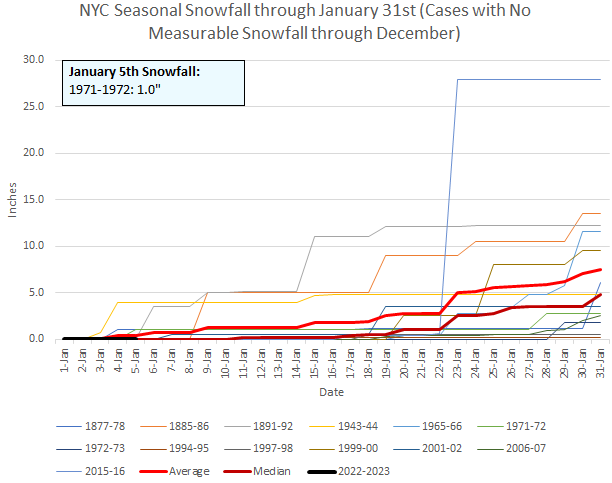-
Posts
22,981 -
Joined
Content Type
Profiles
Blogs
Forums
American Weather
Media Demo
Store
Gallery
Everything posted by donsutherland1
-
Morning thoughts… It will be partly sunny and mild. High temperatures will reach the middle and upper 40s in most areas. Likely high temperatures around the region include: New York City (Central Park): 46° Newark: 48° Philadelphia: 48° After a dry weekend, a weak system could bring some rain or wet snow to the region Sunday night into Monday. Normals: New York City: 30-Year: 39.7°; 15-Year: 40.7° Newark: 30-Year: 40.2°; 15-Year: 41.4° Philadelphia: 30-Year: 41.6°; 15-Year: 42.5°
-
Here’s the list. https://www.ncei.noaa.gov/access/monitoring/rsi/nesis
-
That was another awesome blizzard. That the models suddenly trended from an offshore solution to a blockbuster storm made it even more memorable.
-
It was an incredible and unforgettable blizzard. I was in the Washington area at the time and it was amazing how it shut down the entire area.
-
Some photos from the Blizzard of 1996. https://www.digitalsnowmuseum.org/photo1996x.html For now, the only snow we have is in our memories or the virtual kind on models.
-
The second warmest opening week of January is nearing an end with a slow cooling trend underway. That cooling trend will continue through the weekend. The second week of January will be cooler, but a cold outcome is unlikely. Some guidance suggests that there could be a sharper but brief cold shot just before mid-month. However, once moderate support for snowfall during the January 13-15 period has been declining. Just 18% of 12z EPS members now show 1" or more snow for New York City. Prior to then, there is a low probability of measurable snowfall Sunday night into Monday. 2022 became the 14th year during which New York City received no measurable snowfall through December 31st. During the 13 prior years, mean seasonal snowfall was 16.0" (median seasonal snowfall: 16.3"). Just 8% of those winters rallied to see 30" or more seasonal snowfall. 31% of those winters wound up with less than 10" of seasonal snowfall. Just under half (46%) had 20" or more seasonal snowfall. The lowest seasonal snowfall for those cases of 2.8" was recorded in 1972-1973. The highest seasonal snowfall for those cases was 32.8", which occurred during 2015-2016. The ENSO Region 1+2 anomaly was -0.3°C and the Region 3.4 anomaly was -0.7°C for the week centered around December 28. For the past six weeks, the ENSO Region 1+2 anomaly has averaged -0.48°C and the ENSO Region 3.4 anomaly has averaged -0.87°C. La Niña conditions will likely persist through mid-winter before fading to neutral conditions. The SOI was +17.44 today. The preliminary Arctic Oscillation (AO) was -1.814 today. On January 4 the MJO was in Phase 7 at an amplitude of 1.099 (RMM). The January 3-adjusted amplitude was 1.353 (RMM).
-
The once moderate potential for measurable snow during the January 13-15 period has continued to decline on the EPS ensembles.
-
-
Yes, that’s Celsius.
-
Some low snowfall winters here have had big Southeast or Lower Mid-Atlantic snowstorms. Examples include 1972-73, 1979-80, and 2001-02 (as you referenced above).
-
Offshore may be more likely.
-
Overnight, not much has changed from my initial thinking concerning the potential January 13-15 snowfall. The overall pattern is not consistent with those that have seen big snowfalls based on the forecast teleconnections. There remains a moderate probability that New York City will see a measurable snowfall. The probability of a large (10" or more) snowfall remains very low. Given the timeframe involved, things can change. Below is recent data from the EPS ensembles for New York City:
-
Morning thoughts… Light rain will end. Clouds could break during the afternoon. High temperatures will reach the upper 40s and lower 50s in most areas. Likely high temperatures around the region include: New York City (Central Park): 47° Newark: 50° Philadelphia: 50° A dry weekend lies ahead. Normals: New York City: 30-Year: 39.9°; 15-Year: 40.8° Newark: 30-Year: 40.3°; 15-Year: 41.5° Philadelphia: 30-Year: 41.7°; 15-Year: 42.7°
-
Yes. That’s a big part of it. That happened in 2001-02, as well.
-
Tonight and tomorrow will see some showers. Readings will be mainly in the 40s. The slow cooling trend will continue through the weekend. Nevertheless. daily temperatures will continue to run warmer than normal through the first 10 days of January. Overall, readings will average about 15° above normal during the first week of the month. The second week of January will see some cooling from the first week's exceptional warmth, but a cold outcome is unlikely. Some guidance suggests that there could be a sharper but brief cold shot just before mid-month. There is moderate ensemble support for snowfall during the January 13-15 period with 39% of 12z EPS members showing 1" or more snow. 2022 became the 14th year during which New York City received no measurable snowfall through December 31st. During the 13 prior years, mean seasonal snowfall was 16.0" (median seasonal snowfall: 16.3"). Just 8% of those winters rallied to see 30" or more seasonal snowfall. 31% of those winters wound up with less than 10" of seasonal snowfall. Just under half (46%) had 20" or more seasonal snowfall. The lowest seasonal snowfall for those cases of 2.8" was recorded in 1972-1973. The highest seasonal snowfall for those cases was 32.8", which occurred during 2015-2016. The ENSO Region 1+2 anomaly was -0.3°C and the Region 3.4 anomaly was -0.7°C for the week centered around December 28. For the past six weeks, the ENSO Region 1+2 anomaly has averaged -0.48°C and the ENSO Region 3.4 anomaly has averaged -0.87°C. La Niña conditions will likely persist through mid-winter before fading to neutral conditions. The SOI was +13.43 today. The preliminary Arctic Oscillation (AO) was -1.632 today. On January 2 the MJO was in Phase 7 at an amplitude of 1.241 (RMM). The January 1-adjusted amplitude was 1.369 (RMM).
-
Yes. There was a big ice storm that winter. I am not aware of ice records.
-
Yes, that’s 2015-16.
-
In the Southeast, Winter 1972-73 was among the snowiest. A video from that winter's benchmark storm:
-
-
Neutral phases had even lower maximum snow amounts for the teleconnection range. Cluster analysis hinted that an offshore outcome was somewhat more likely than some of the other possible scenarios. There may be more cold air earlier in the timeframe than afterward.
-
1916-01-01 37 23 1916-01-02 38 31 1916-01-03 38 21 1916-01-04 33 22 1916-01-05 46 M 1916-01-06 52 24 1916-01-07 52 20 1916-01-08 25 11 1916-01-09 27 12 1916-01-10 42 21 1916-01-11 49 35 1916-01-12 36 29 1916-01-13 48 29 1916-01-14 36 11 1916-01-15 26 6 1916-01-16 35 23 1916-01-17 33 12 1916-01-18 23 9 1916-01-19 30 14 1916-01-20 38 19 1916-01-21 52 37 1916-01-22 54 37 1916-01-23 50 34 1916-01-24 40 25 1916-01-25 53 29 1916-01-26 56 38 1916-01-27 65 44 1916-01-28 65 M 1916-01-29 40 23 1916-01-30 39 26 1916-01-31 51 36
-
It has been a long and increasingly demoralizing march across the calendar through December into early January in wait for measurable snow in New York City and Philadelphia. Social Media has periodically lit up whenever a stray operational run popped a big snowstorm into existence (when subsequent runs popped it back out of existence, there was silence). That the event was depicted well beyond 7 days seemed to have no impact whatsoever in a seeming scramble to be "first" not "right." Reality is sobering. Model skill scores show that the extended range remains shrouded in the fog of uncertainty despite advances in the modeling. Objective conclusions respect uncertainty. They are not beholden to preconceived beliefs about future outcomes, much less desires for future outcomes. Where do we stand now? Without measurable snowfall today, Winter 2022-2023 will be among just 11 winters that saw no measurable snowfall through January 5th at Central Park. The wait will go on. Is there potential? The January 13-15 timeframe suggests some potential exists to break the measurable snow drought. 1. Guidance has shifted toward a brief period of colder weather leading up to mid-month. A larger share of time with readings near or below freezing offers a window for accumulating snow. If, of course, there is a system to bring precipitation. 2. Discrete systems cannot be identified much less pinned down with any degree of reliability at long timeframes. But ensembles can provide insight. Just over one-third (14/51 or 35%) of members on the 1/5 0z cycle of the EPS ensembles had 1" or more snowfall in New York City during the broad timeframe mentioned above. 1" or above is useful proxy for measurable snowfall at this range, because that amount rises above the general "noise" of variability in scenarios with lesser amounts. 3. Adjusting key teleconnections for potential error (widening ranges) and then looking at the 1950-2022 period can also provide some insight (not enough for firm predictions given sample size issues and the importance of synoptic features). At long ranges, scenarios must suffice. Looking at January cases where the AO ranged from -1 to +1 and the PNA ranged from -0.5 to +0.5, there were three storms that delivered 10" or more snow to at least one of the following cities: Boston, New York City, Philadelphia, or Washington, DC. The biggest was the January 1978 snowstorm. The others occurred in January 1954 and January 1987. The number of 10"+ cases for that teleconnection range during January 1950-2022 were as follows: Boston: 1; New York City: 1; Philadelphia: 2; Washington, DC: 1. The number of 4"+ cases were: Boston: 12; New York City: 8; Philadelphia: 7; Washington, DC: 5. This would imply low potential for a 10" or greater snowfall and very low potential for a widespread 10" or above snowfall on coastal plain. However, all of the 10" cases occurred when El Niño conditions were present. Currently, La Niña prevails. The biggest snowfalls during La Niñas for the above constraints on time and teleconnections were: Boston: 6.5"; New York City: 6.3"; Philadelphia: 6.6"; and Washington, DC: 4.1". Potential spoiler alert: None of the 500 mb patterns preceding the above storms were a close match to what is currently forecast (EPS) 192-240 hours out. January 1987 is almost a complete opposite with its ridge-trough positions. 4. History is an imperfect guide to the future. A historical approach has limitations. It says nothing about synoptic systems. What do the ensembles say? Just 3/51 (6%) members showed 10" or more snowfall in New York City. All three were widespread big snowfalls, though. History + Ensembles can provide value when agreement exists. From the above, one can cautiously conclude that January 13-15 offers a window of opportunity to break the measurable snow drought. If things go really well, there might be a small chance of a big snowfall. Much can still change given the timeframe involved. There remain no guarantees. Chatter about big amounts on Twitter or Instagram or Facebook (with or without the posting of long-range snow maps) is pure speculation, as it goes far beyond the bounds of objectivity, regardless of the author.
-
Yes. That’s JFK’s only such case on record.
-
Only 1977 (-1) and 1985 (-2) had subzero lows at JFK. 1980 had a low of 3. 1983 holds the record for 12/25 at JFK with a low of 2.
-
Morning thoughts… Today will be partly to mostly cloudy and mild. High temperatures will reach the middle and upper 50s in most other areas. Likely high temperatures around the region include: New York City (Central Park): 54° Newark: 57° Philadelphia: 61° Some showers or light rain is possible tonight into tomorrow. Normals: New York City: 30-Year: 40.0°; 15-Year: 40.9° Newark: 30-Year: 40.5°; 15-Year: 41.7° Philadelphia: 30-Year: 41.8°; 15-Year: 42.8°





